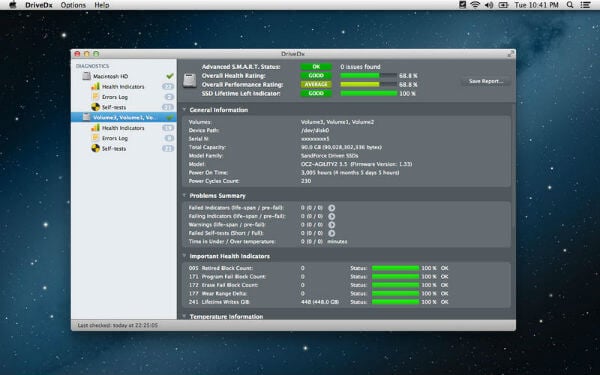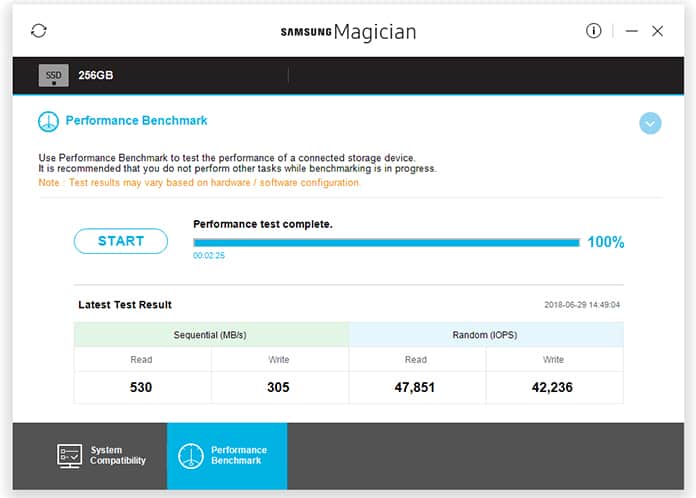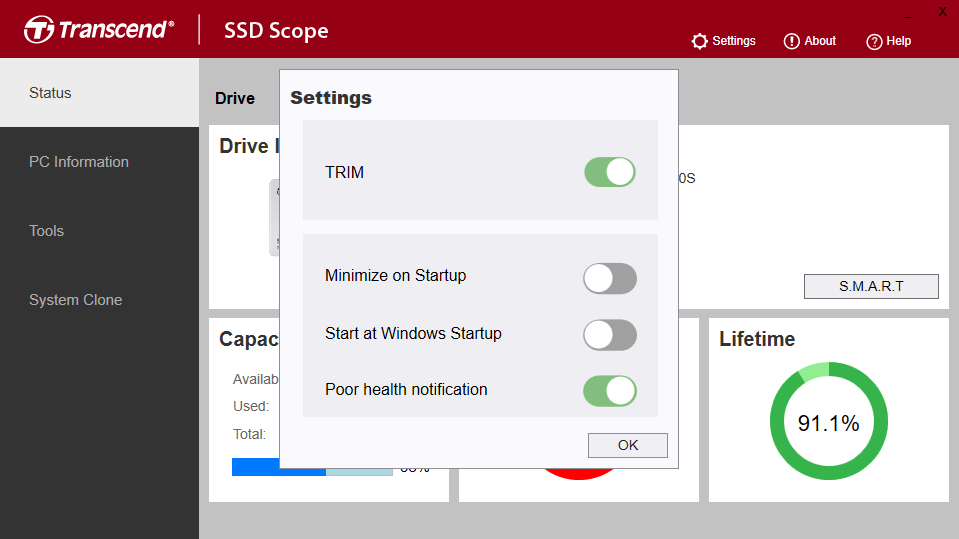This free downloadable tool enables your Crucial SSD to become even faster and allows it to get periodic updates so it’s constantly performing at its best. With Storage Executive, you can see how much storage (GB) you’ve used, download the latest firmware, monitor the drive’s temperature, reset your encryption password, and enable the. DriveDx - the most advanced drive health (S.M.A.R.T.) diagnostics and monitoring utility. Save yourself the data loss and downtime that is associated with unexpected SSD and HDD failures. Don't worry about losing your important data, music, and photographs.
SSDs are beginning to dominate the hard drive market by replacing the roles of HDD in laptops and high-end desktops. SSD hard drives offer high performance at low power dissipation compared to the ordinary hard disks. However, it is important to make sure SSD drive is healthy in order to keep the good performance.

In this article, you will learn how to check SSD Health on a Windows or Mac computer. There are a number of tools to check SSD health, but in this article, we’ll discuss only the best Windows and Mac Free tools to check SSD Health and Monitor Performance.
In case an SSD drive failure has happened to you and caused data loss, it is important to know how to recover deleted files from SSD. Don’t hesitate to get lost files back with file recovery software.
Method #1. How to Check SSD Health Using CrystalDiskMark
CrystalDiskMark is actually a benchmarking tool for testing the speed of write/read, which is one of the most important indicators of your SSD health. Download the small size package, then install it to your computer. The free app will tell you the current state of your SSD.
Check Ssd Health Mac Os
CrystalDiskMark will allow you to choose a partition or folder of computer built-in or removable hard disk, then test the read/write speed under simulated conditions, like 4K and sequential. Once the test is done, you can know the SSD health status by comparing the result with advertised speed.

Method #2. How to Check SSD Hard Drive Health Using SSD Life
You can buy a Pro version, or you can use the free version of SSD Life. The Pro Version isn’t very expensive so if you like the free version then you may want to try the full app. Once you’ve downloaded the app, install and run it. It will then tell you how your SSD is doing.
This tool will measure your SSD’s lifespan giving you the opportunity to plan well for your data. With the knowledge of your SSD’s lifespan, you can know when to back up your data before your SSD wears off completely. SSD Life can work with most SSD manufacturers such as Kingston, OCZ, and Apple MacBook Air built-in SSD.
Method #3. How to Check SSD Health Using CrystalDiskInfo
CrystalDiskInfo is another freeware offered by individual developer. It supports a part of USB, INTEL RAID and NVMe, and helps to monitor SSD’s health status and temperature. Once installed, the intuitive interface will show you the health status of your SSD, with a list of parameters, including critical warning, available spare, media and data integrity errors, etc. There are several more interesting functions hidden in the menu.
CrystalDiskInfo has three editions, namely Standard Edition, Shizuku Edition and Kurei Kei Edition, with Japanese anime images as UI background in the latter two versions. There is no more extra difference but for giving users fresh experience.
Method #4. How to Check SSD Health Using Smartmonotools
Smartmonotools is an open-source tool for professional users since the operation will carry out in a CMD window. It offers real time monitoring of SSD Hard Disk with two programs, smartctl andsmartd. The two programs control and monitor computer storage systems using the Self-Monitoring, Analysis and Reporting Technology (S.M.A.R.T) system.
Once installed, Smartmonotools will display early warning signs of SSD problems detected by S.M.A.R.T., often giving notice of impending failure while it is still possible to back up the data. It supports ATA/ATAPI/SATA-3 to 8 disks and SCSI disks and tape devices. The tool can run on Mac OS X, Linux, BSD, Windows and others.
Method #5. How to Check SSD Health Using Hard Disk Sentinel
HDSentinel, short for Hard Disk Sentinel, supports Windows, Linux and DOS platforms. This SSD monitoring software is built to find, test, diagnose and repair SSD problems. Whether it is an internal or external SSD connected USB or e-SATA, this tool can scan and recognize your SSD health and generate reports with possible fix to solve the errors.

HDSentinel is also able to show you the estimated remaining lifetime and lifetime writes. The pro version provides more functions, like automatic backup.
Method #6. How to Check SSD Health Using Intel SSD Toolbox
The Intel Solid-State Drive Toolbox is a drive management software that allows you to view SSD information, including:
• Model number, capacity and firmware version
• Drive health
• Estimated drive life remaining
• Identify device information
• Optimize the performance of an intel SSD using Trim functionality
Best Ssd For Mac Pro
Intel SSD Toolbox allows users to check computer system information and SSD status. It also provides system tuner function to optimize the operating system. However, SMART DRIVE and SMART Estimated Life Remaining are available for Intel SSDs only.
To Sum up
SSD helps computer system run faster and unless you’ve used one in your system, it’s hard to explain or truly appreciate how great it is. Fortunately, it will be more affordable and their lifespan will have improved. Nevertheless, if you have SSD, it is always important to keep an eye on its health status. Any one or two of the above free tools are good for home users. It is also important to back up SSD for important data.
Related Articles
New Articles
Keeping you Mac's hard drive or SSD healthy is hugely important. By monitoring and checking your Mac hard drive's health, you can anticipate potential problems and prevent potentially catastrophic crashes. How do you know if your Mac is working properly?
Fortunately, there are a number of tools available that allow to to check the health of a drive and fix problems before they become serious.
Best Apps to Check Your Mac Hard Drive Health
One of the best apps for alerting you to potential problems is iStat Menus, available in Setapp. Once you've installed it, iStatMenus sits in your Mac's menu bar and monitors not just your hard drive, but its CPU, RAM and network traffic, among other things.
iStat Menus, and the other disk monitoring tools available for macOS, monitor what is knows as SMART status. SMART stands for Self-Monitoring, Analysis and Reporting Technology and is installed on most hard drives and SSDs. In order to use it, you need software to analyze and display what it finds, and that's where iStatMenus comes in. Check out how to clone mac hard drive.
Monitoring SMART reports won't prevent your hard drive from failing, but it will reduce the likelihood of problems occurring.

Note: As of 2016, Apple no longer allows software tools to check the SMART status of an SSD. So iStatMenus won't repot anything on Macs shipped in 2016 or later.
There are other steps you can take to keep your hard drive or SSD healthy. CleanMyMac X has a number of maintenance routines. While most of them are designed to keep your Mac running smoothly, one of them is an excellent way to keep your hard drive in good shape.
How to verify Startup disk
- Launch Setapp, search for CleanMyMac, and open it.
- When CleanMyMac has launched, look on the left hand side of its window for the Speed section and click Maintenance.
- Click the check box next to 'Repair Disk Permissions' to verify startup disk and then click the 'Run' button at the bottom of the window.
- Click OK in the dialog box that opens. Click 'Run' again. View the result
Identifying bad sectors with Disk Drill
Sectors are blocks of space on a disk drive and bad sectors are blocks that cannot be read because, for whatever reason, they're damaged. When Disk Drill attempts to recover data from a hard drive that's failed or one where you've mistakenly deleted files, it marks sectors it can't read from as bad. That means that it won't try to recover data from them in the future.
You can't fix bad sectors, the drive's firmware should identify them and prevent them from being written to. If there's data stored in them and you need to recover it, you're out of luck. But by monitoring how many of them there are on a drive, you can keep an eye on its health and decide whether it's time to replace it, if the number of bad sector starts to increase quickly.
Here's how to identify bad sector in Disk Drill:
- Open Disk Drill app in Setapp. When it launches, it will ask if you want to 'Monitor my disks for hardware issues'. Say Yes. If you already have Disk Drill installed but didn't check that option when you launched it the first time, go to the Preferences, click the SMART tab and check the box next to 'Monitor my disks for hardware issues.'
- Start a recovery session. In Disk Drill's main window, select the volume 'Macintosh HD', or whatever you've called your Mac's hard drive. Click Recover. Let the recover session run and complete.
- Check bad sectors. Once the recovery session has completed and saved, go back to the main Disk Drill window. Click the gear icon next to the drive you ran the recovery session on and click the bottom item on the menu 'Specify bad blocks.' This tool is designed to allow you to tell Disk Drill which blocks are bad and you don't want it to scan, but it will also display bad sectors it has identified.
How to avoid problems from an unhealthy hard drive
You should always backup your hard drive regularly, but it's even more important to do it when you suspect your hard drive is having problems. If you identify problems with a hard drive using any of the steps above, you should consider increasing the frequency of your backups and test them to make sure you can recover data if you need to – a backup routine is useless if you can't restore data. You should also consider using Get BackUp Pro to make a complete clone of the drive, that way, in an emergency you can boot from the clone and be back up and running immediately. Click here to read about how to backup your Mac. Get Backup Pro, also available in Setapp, is an excellent tool for making regular backups.
How to recover from a failed hard drive
If it's already too late and your hard drive has failed and lost data, you should try to recover the data before you do anything else.
These might also interest you:
Ssd Health Checker Mac
Meantime, prepare for all the awesome things you can do with Setapp.
Read onSign Up
Mac Pro Ssd Upgrade
